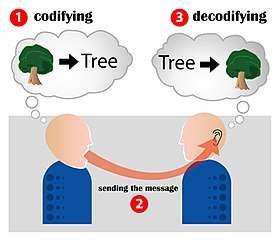Biocommunication (science)
In the study of the biological sciences, biocommunication is any specific type of communication within (intraspecific) or between (interspecific) species of plants, animals, fungi, protozoa and microorganisms. Communication basically means sign-mediated interactions following three levels of (syntactic, pragmatic and semantic) rules. Signs in most cases are chemical molecules (semiochemicals), but also tactile, or as in animals also visual and auditive. Biocommunication of animals may include vocalizations (as between competing bird species), or pheromone production (as between various species of insects),[1] chemical signals between plants and animals (as in tannin production used by vascular plants to warn away insects), and chemically mediated communication between plants[2][3] and within plants.
Biocommunication of fungi demonstrates that mycelia communication integrates interspecific sign-mediated interactions between fungal organisms soil bacteria and plant root cells without which plant nutrition could not be organized. Biocommunication of Archaea represents keylevels of sign-mediated interactions in the evolutionarily oldest akaryotes.
Biocommunication, biosemiotics and linguistics
Biocommunication theory may be considered to be a branch of biosemiotics. Whereas Biosemiotics studies the production and interpretation of signs and codes, biocommunication theory investigates concrete interactions mediated by signs. Accordingly, syntactic, semantic, and pragmatic aspects of biocommunication processes are distinguished.[4] Biocommunication specific to animals (animal communication) is considered a branch of zoosemiotics.[5] The semiotic study of molecular genetics, can be considered a study of biocommunication at its most basic level.[6]
Language hierarchy
Given the complexity and range of biological organisms and the further complexity within the neural organization of any particular animal organism, there is a variety of biocommunication languages.
A hierarchy of biocommunication languages in animals has been proposed by Subhash Kak: these languages, in order of increasing generality, are associative, re-organizational, and quantum.[7][8] The three types of formal languages of the Chomsky hierarchy map into the associative language class.
See also
Notes
- ↑ Ananthakrishnan, T (1998). Biocommunication in Insects. Science Publishers. p. 104. ISBN 1-57808-031-2.
- ↑ Taiz, Lincoln; Eduardo Zeiger (2002). "Plant Physiology Online". a companion to Plant Physiology, Third Edition. Sinauer Associates. Archived from the original on December 7, 2006. Retrieved 2006-12-26.
- ↑ Farmer, EE; CA Ryan (1990). "Interplant Communication: Airborne Methyl Jasmonate Induces Synthesis of Proteinase Inhibitors in Plant Leaves". Proceedings of the National Academy of Sciences. 87 (19): 7713–7716. doi:10.1073/pnas.87.19.7713. PMC 54818. PMID 11607107. Retrieved 2006-12-31.
- ↑ Tembrock, Günter (1971). Biokommunikation: Informationsübertragung im biologischen Bereich. Berlin: Akademie-Verlag.
- ↑ Sebeok, Thomas (ed.) 1977. How Animals Communicate. Bloomington: Indiana University Press.
- ↑ Emmeche, Claus; Jesper Hoffmeyer (1991). From Language to Nature - the semiotic metaphor in biology. Semiotica 84 (1/2): 1-42, 1991. Archived from the original on October 14, 2006. Retrieved 2006-12-31.
- ↑ Kak, S. The three languages of the brain: quantum, reorganizational, and associative. In Learning as Self-Organization, Karl Pribram and J. King (editors). Lawrence Erlbaum Associates, Mahwah, NJ, 185-219, 1996.
- ↑ Kak, S. Communication languages and agents in biological systems. In: Biocommunication: Sign-Mediated Interactions between Cells and Organisms. Eds.: J. Seckbach & R. Gordon. London, World Scientific Publishing: 203-226, 2016.
